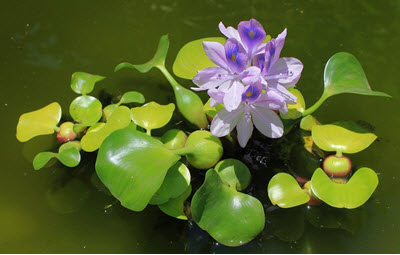Contents
On this page, we are going to talk about different plants that are good choices for your pond. Some of these plants require a tropical or subtropical climate while other will do better in cold climates. Many of these plants will need to winter indoor if you live in an area where the water freezes.
Water lilies are one of the most famous pond plants of all but I am not going to talk about water lilies at all in this article. The reason for that is that I have an article dedicated to water lilies here.
Floating plants
Floating plants are just that, floating. They do not need to be planted and will not attach themselves to anything. They will freely float over the surface of the pond. Most floating plants grow extremely fast and it is enough to add one or two plants to any pond. They will quickly multiply. Many species can double in size each week.

Floating plants can become a nuisance due to their fast-growing nature. You will often have to remove some of the plants each week to prevent them from taking over completely. If you remove half of the plants this week then you will be back at the same amount in about a week. Some pond owners prefer to not keep floating plants for this very reason. I do however prefer to use them since they look good and provide good habitat for fish and frogs.
Popular floating plants include:
- Water Hyacinths (Very beautiful and extremely fast growing)
- Water sprite
- Water lettuce
- Pistia stratoides
- Salvia Natans
- Mosaic plants
Sump Plants
Sump plants are plants that like to grow in water soaked dirt. Water soaked area like this can be very beautiful and make great habitats for frogs and other amphibians. I generally recommend that you include an area like this in one corner of the pond.
Below we are going to look at a few types of sump plants
Water sausage
 Water sausages (Typha) are also known as reeds, cattail, punks, and corn dog grass. These plants look like any other reed for most of the year but will develop beautiful brown sausages during the fall. These plants are found in Northern USA, Canada, Northern Europe and Northern Asia. They can be kept in ponds in cooler areas. They do not always do well in warmer areas.
Water sausages (Typha) are also known as reeds, cattail, punks, and corn dog grass. These plants look like any other reed for most of the year but will develop beautiful brown sausages during the fall. These plants are found in Northern USA, Canada, Northern Europe and Northern Asia. They can be kept in ponds in cooler areas. They do not always do well in warmer areas.
Elephant ears
The elephant ears (Alocasia ) is a plant with very large green leaves. There is also a variant of this plant that has dark red leaves. The two colors can be very beautiful if grown together. These plants are found in south and central America where they grow on the edges of riverbeds. They do very well next to a pond. They can be planted in the sump zone or in the dirt surrounding the pond. They are able to adapt to most conditions. They do not do well during extended periods of drought.
Crinum lilies
Crinum lilies are a group of lilies. Some of which prefer to grow in a sump area or even fully submerged. Some species of crinum are common aquarium plants. Crinum lilies are very beautiful and they can make any pond more beautiful. In colder climates, they will need to be brought in during the winter. Most species can be planted both in the sump area and in the dirt surrounding the pond. Crinum lilies can be bought as bulbs.
Submerged plants
Submerged plants are plants that are planted below the surface of the water. They will make your pond look more natural and will provide the fish in your pond with a good habitat. Many pond owners do not keep submerged plants so doing so can really set you apart. The best place to buy fully submerged plants is your local aquarium store.
Examples of good choices of submerged plants include.
- Java fern: A beautiful green plant that can grow on any surface.
- Anubias: A slow growing plant that can grow both under and over the surface. Looks very good on rocks and driftwood.
- Rotala Macaranda: A beautiful red plant that can provide a splash of color in the pond. Can be hard to keep but will grow very quickly if it likes it in your pond. Ludwigia repens can be a good alternative if you can not get Rotala to grow. Ludwigia will become red if given enough light.
- Cabomba: A simple green plant that can be fast growing. This plant is banned in Europe due to its ability to spread in local rivers and lakes.
- Alternanthera reineckii: An easy to keep, red plant. Will do well in most conditions provided it get enough light and the water is warm enough. There are many different morphs of this plant. Some look almost purple.
- Cryptocoryne: There is a large number of different Cryptocoryne species available in the market. Some are green while others are red or other colors. They can look very good if planted in large groups. It is common that the plants lose all leaves after being planted in a new spot. They will usually sprout new leaves within a few weeks,